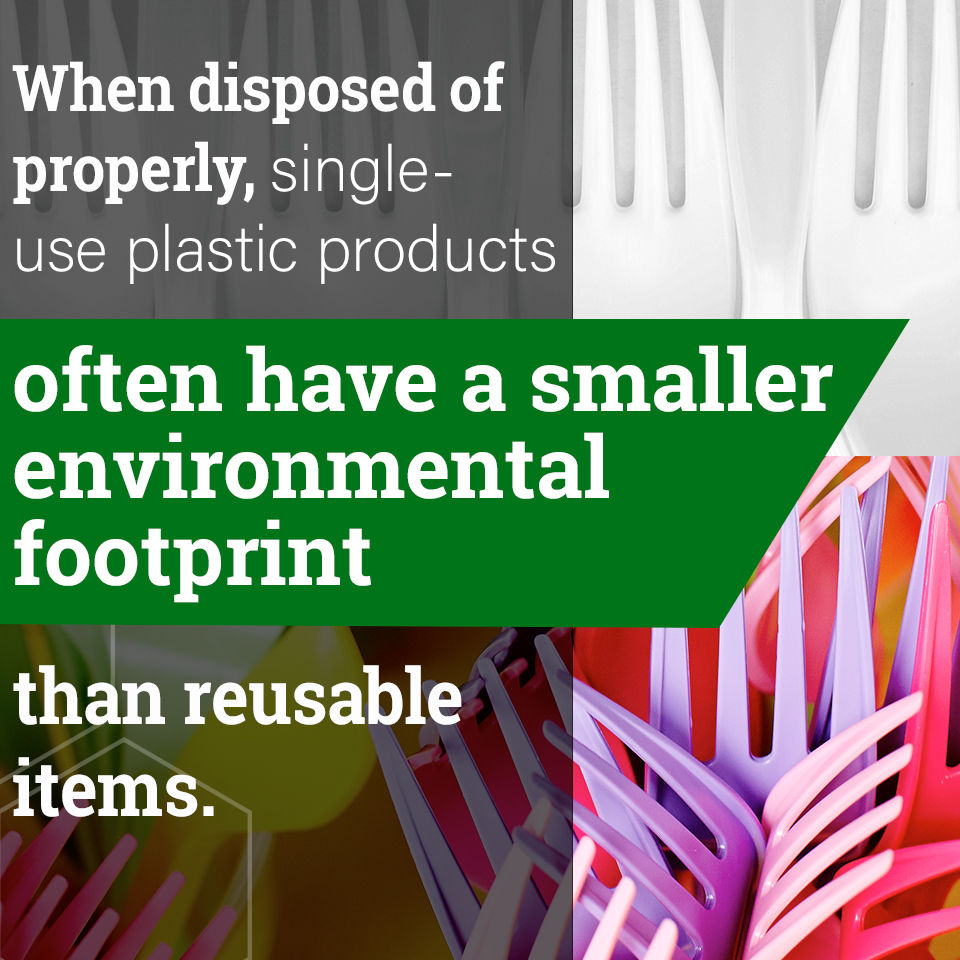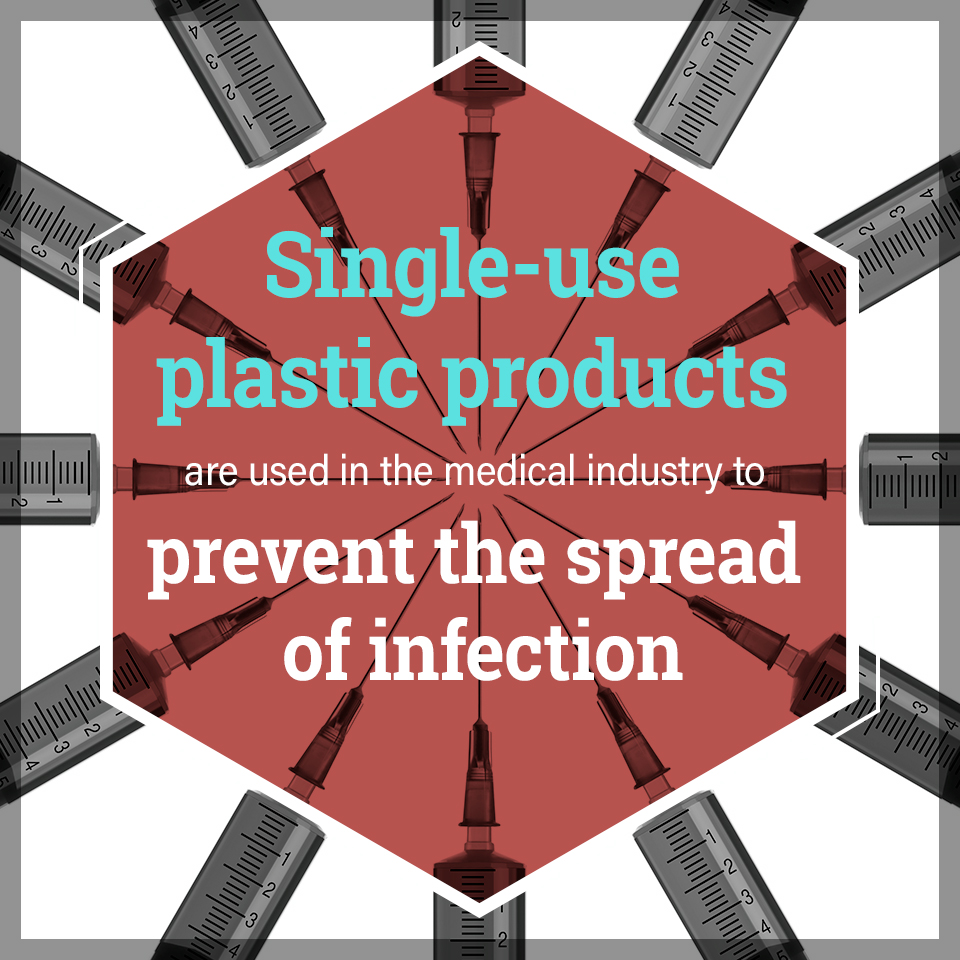Consumers benefit from the advantages in cost, convenience and energy efficiency that single-use items provide. But using items like plastic shopping bags, bottles, utensils and straws requires users to commit to disposing of them properly—whether that means recycling them or, at the very least, ensuring they make their way into a proper waste receptacle.
Many of these items were introduced for specific reasons. Disposable plastic utensils, for example, became popular with Americans in the 1960s. They were used at home and in restaurants to cut labor costs and the energy required to clean traditional silverware. They also cut down on the spread of diseases.
In the late 1970s and early 1980s, plastic bags were introduced to address concerns about how many trees were being cut down in order to produce paper bags, which were more common at the time. Ever since then, the process of making these products has gotten more efficient.
Today, many other plastic items are designed to be used just once, delivering benefits beyond convenience and cost savings and ultimately supporting public health. For example, single-use plastic products that prevent the spread of infection are crucial in the medical industry. Instruments such as syringes, applicators, drug tests, bandages and wraps are often made to be disposable. Furthermore, single-use plastic products have been enlisted in the fight against food waste, keeping food and water fresher for longer and reducing the potential for contamination.
Because of its safety, flexibility and cost-effectiveness, plastic is the material of choice for these types of products.
We all benefit from single-use plastic products. But by choosing to use these products, people agree to dispose of them properly. There can be challenges when it comes to disposing of some single-use products. Many of them aren’t designed to be reused, and because of their makeup, some can’t be recycled using traditional methods. This means many people toss them in the trash—contributing to waste in landfills—or don’t bother to dispose of them properly at all, littering them and ultimately sending them into the environment, where they can harm plants and wildlife.
While it’s better for single-use plastic products to end up in a landfill than to become litter, the ultimate goal is that all these products can be collected and converted into energy or recycled.
The people of this industry are creating new ways to address challenges by making it more profitable to recycle a plastic product than it is to litter or landfill it. Examples include:
- Trex: This decking company uses recycled grocery bags, bread bags, dry cleaning bags and more to make environmentally responsible outdoor products.
- BD, one of the world’s largest medical device companies, manufactures a number of products using a variety of recycled materials for its Recykleen™ brand.
- Brand Pledges: Some of the world’s largest companies have pledged to eliminate the amount of waste they send to a landfill or to use more recycled materials in their products and packaging, thereby creating a bigger market for recycled content and incentivizing recyclers to expand their operations to collect more material.
- Coca-Cola pledged to collect and recycle the equivalent of every bottle or can it sells throughout the world by 2030.
- PepsiCo created a goal of designing all its packaging to be recyclable, compostable or biodegradable, while increasing its use of recycled materials and decreasing its packaging’s carbon impact.
- SC Johnson has set a goal to send zero manufacturing waste to landfill from its factories by 2021, a process that will include increased reusing and recycling.
- John Deere announced a pledge to recycle 75% of its total waste by 2018.
- The Ford Motor Company set a five-year goal of reducing waste to landfill by 40% per vehicle and continues to expand the use of recycled content in its vehicles, particularly in the development of new upholstery fabrics.
- Toyota’s Environmental Challenge 2050 committed the company toward creating a recycling-based society through the use of eco-friendly materials, the use of auto parts for longer, the development of recycling technologies and the manufacture of new vehicles from end-of-life ones.
- Nissan set a target of increasing the usage rate for recycled materials per new vehicles by 25% in Japan, the U.S. and Europe.
- At its stores, ANN INC. provides shopping bags made with between 40% and 80% post-consumer waste.
- Clorox set a goal to have 10 zero-waste-to-landfill manufacturing sites by 2020.
- McDonald’s pledged that its product packaging would come from renewable, recycled or certified sources by 2025.
- Ecover, a company that makes environmentally friendly cleaning products, said all its bottles would be made with 100% recycled plastic by 2020.
- Packaging company Amcor pledged to make all its product packaging recyclable or reusable by 2025.
- The Danone water bottles used by the Evian brand will be made with 100% recycled plastic by 2025.
- Unilever has committed to making 100% of its plastic packaging recyclable by 2025.
- Walmart announced that by 2025, 100% of its packaging for its private-brand products would be recyclable.
- By 2025, L’Oréal’s plastic packaging will all be rechargeable, refillable, recyclable or compostable.
- Through its Demand Champions program, the Association of Plastic Recyclers has secured commitments from a number of companies throughout the plastics supply chain to purchase more post-consumer recycled material. The list includes brand owners—such as Campbell’s, Coca-Cola, Keurig, Nestlé, Procter & Gamble and Target—as well as plastics companies—such as Berry Global, Champion Polymer Recycling, Clean Tech Incorporated, Denton Plastics, Envision Plastics, KW Plastics, Merlin Plastics and Plastipak.
It’s paramount to dispose of single-use plastics properly. Every person who selects single-use products has the obligation to make sure these items are recycled or disposed of in a trash can and kept out of the environment. The industry is working to expand our nation’s waste management infrastructure in order to increase access to recycling and to energy recovery technologies. When recycled or converted into energy, these items can continue to make a positive impact on our lives, extending their life and their value beyond a single use.
Consumers and businesses throughout the world benefit from a variety of single-use plastics. Our industry works to increase the acceptance of all plastic products at all recycling facilities across the country and continues to innovate to make it easier to recycle them.
Sources & Resources:
- http://www.superiorplastics.com/plastic-products/the-history-of-plasticware/
- http://www.medicaldesignandoutsourcing.com/what-are-disposable-devices/
- http://newplasticseconomy.org/news/11-companies-commit-to-100-reusable-recyclable-or-compostable-packaging-by-2025
- http://www.theatlantic.com/technology/archive/2014/10/how-the-plastic-bag-became-so-popular/381065/
- http://www.superiorplastics.com/plastic-products/the-history-of-plasticware/
- http://www.firstamericanplastic.com/blog/how-plastics-and-disposable-cutlery-are-used-food-industry
- http://www.allaboutbags.ca/papervplastic.html
- http://www.trex.com/recycling/recycling-programs/
- http://www.sharpsinc.com/
- http://www.bd.com/en-us/offerings/capabilities/sharps-disposal/bd-recykleen-sharps-collectors-and-accessories
- http://www.coca-colacompany.com/stories/world-without-waste
- https://www.pepsico.com/docs/album/policies-doc/packaging-a-z-topics.pdf
- http://www.scjohnson.com/en/press-room/press-releases/10-04-2017/SC-Johnson-Accelerates-Pace-to-Meet-Zero-Waste-to-Landfill-Goal.aspx
- http://www.deere.com/en_US/corporate/our_company/citizenship/environmental_stewardship/ecogoals/ecogoals.page
- http://corporate.ford.com/microsites/sustainability-report-2016-17/operations/waste/index.html
- http://www.toyota-global.com/sustainability/environment/challenge5/
- http://www.nissan-global.com/EN/ENVIRONMENT/CAR/RECYCLE/
- http://responsiblyann.com/sustainableMaterials.asp
- http://www.thecloroxcompany.com/corporate-responsibility/environmental-sustainability/commitments-and-progress/operations/footprint-reduction-summary/waste/
- http://corporate.mcdonalds.com/content/corpmcd/scale-for-good/packaging-and-recycling.html
- http://www.ecover.com/clean-plastic/
- http://www.amcor.com/about_us/media_centre/news/amcor-is-first-global-packaging-company-pledging-t
- http://circular.evian.eco/?name=press-release-jan2018&type=mediaArticle&id=1MeIzLKlrSGSG8eauMA8sI
- http://www.unilever.com/news/Press-releases/2017/Unilever-commits-to-100-percent-recyclable-plastic.html
- http://news.walmart.com/2016/11/04/walmart-offers-new-vision-for-the-companys-role-in-society
- http://www.plasticsrecycling.org/recycling-demand-champions/demand-champion-companies


